By the time they finally wanted to sell their home, it wasn’t easy anymore because demand had plunged, and fewer of those mortgages got paid off.
By Wolf Richter for WOLF STREET.
Mortgages outstanding with rates below 3% declined to a share of 20.7% of all mortgages in Q1, according to data today by the Federal Housing Finance Agency (FHFA). Their share started to decline in mid-2022. But the decline of just 10 basis points Q1 was the smallest since the declines started. Over these three years, the quarter-to-quarter declines of the share of these below-3% mortgages averaged just over 30 basis points, with a range between -20 to -50 basis points (red in the chart).
Similarly, the share of 3-4% mortgages declined by 30 basis points to a share of 32.7%. But the average quarter-to-quarter decline since mid-2022 was nearly 70 basis points, with a range from -50 to -90 basis points (blue). In the chart, the slowdown is visible in the flattening of the curves at the end.
The declining share of these ultra-low-rate mortgages represents the exit of homeowners from the “lock-in effect.” This slowdown in the rates of decline – the slowdown of this exit – is not what the real estate brokers and mortgage lenders were hoping for. But it’s not that locked-in homeowners didn’t want to sell – on the contrary, supply has ballooned as they put their homes on the market. It’s that demand has plunged further in Q1, even below the beaten-down levels from a year earlier, and a lot of them couldn’t sell, and so fewer of these mortgages got paid off.
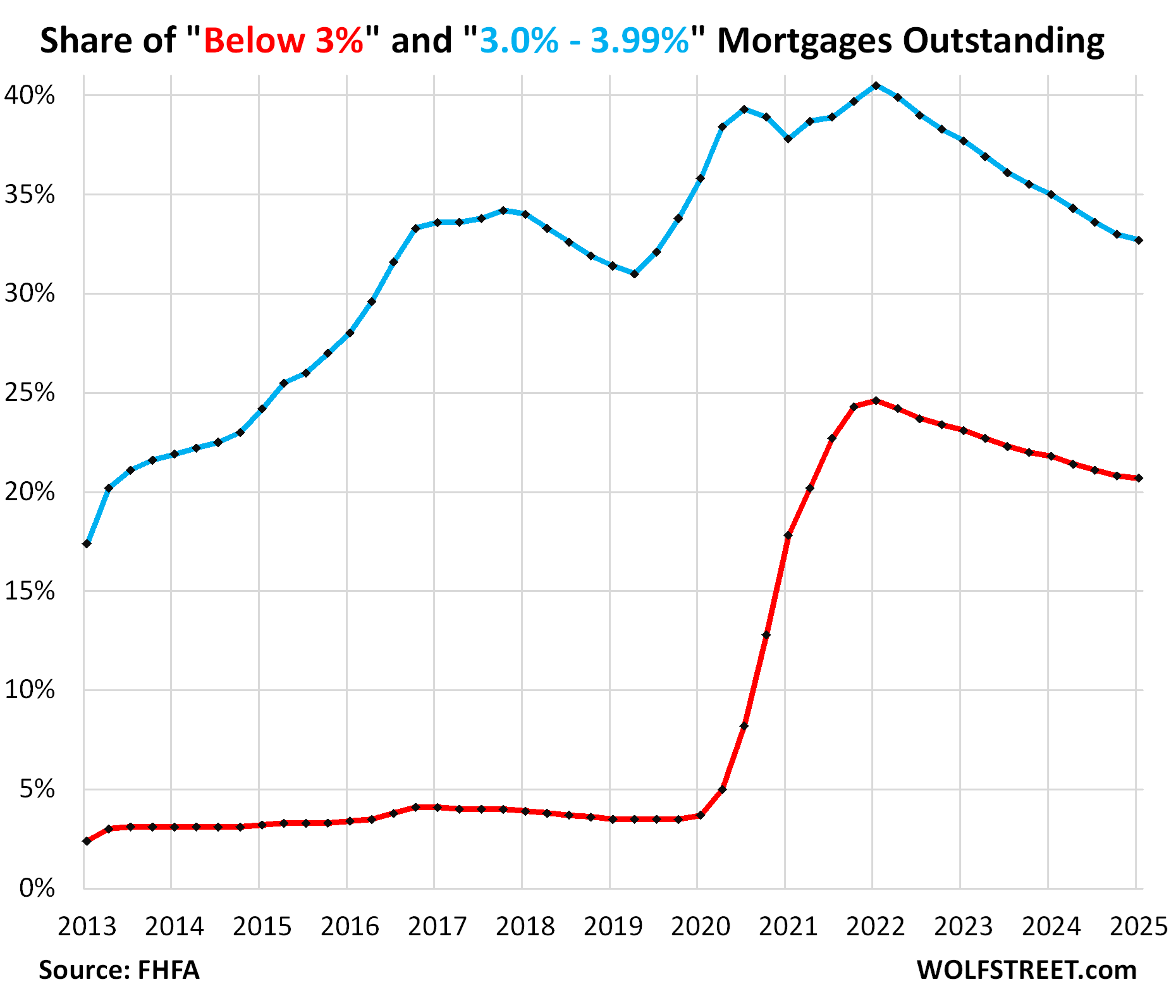
When these low mortgage rates came along in early 2020, they triggered a tsunami of refinancing of higher-rate mortgages, and the number of these outstanding low-rate mortgages exploded through Q1 2022.
The lock-in effect is where homeowners refuse to move because they would have to sell their home and pay off the mortgage, and finance the next home at a much higher mortgage rate. This lock-in effect is in part responsible for the roughly 40% collapse in demand for mortgages compared to 2019, and for the plunge in sales of existing homes – by 23% from 2019 for single-family homes and by 38% for condos.
But even the closest thing to free money that Americans could borrow has slowly been getting paid off because homeowners moved to take a new job or accommodate a larger family, or got divorced, or died.
Or they’d already bought a new home a few years ago and moved into it, but kept the old home to ride up the home-price explosion all the way. And now the carrying costs of that vacant home are becoming a burden, and prices are no longer exploding; but instead in some markets, there are downdrafts in single-family home prices, and in more markets, there are serious downdrafts in condo prices. And so they put these vacant homes on the market, and pay off the mortgage if they sell the home.
The hope of brokers and mortgage lenders was that the lock-in effect would loosen up, and that more of these locked-in homeowners would return to the market as buyers and sellers and generate commissions, fees, and points coming and going.
The share of 6%-plus mortgages rose by 60 basis points to a share of 18.8% in Q1, the highest since Q1 2016. Their share has multiplied by over 2.5, from 7.3% at the low point in Q2 2022.
But that 60-basis point increase in the share was the slowest increase since increases took off in mid-2022. Between Q3 2022 and Q4 2024, the increases averaged nearly 120 basis points per quarter, with a range from +90 to +140 basis points.
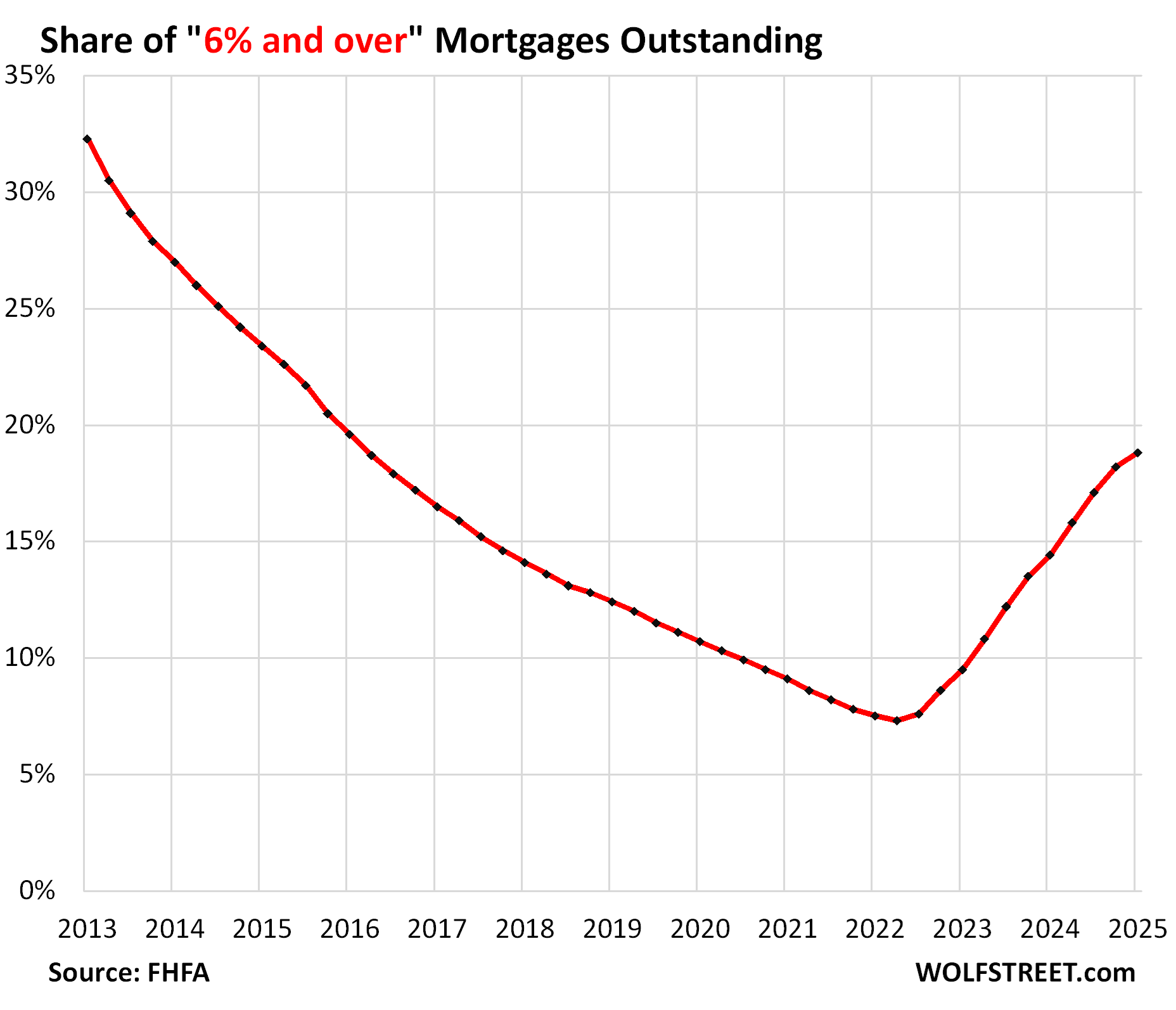
The ultra-low-rate mortgages were a brief phenomenon.
The below-3% mortgage rates burst on the housing scene from mid-2020 to October 2021, as a result of the Fed’s massive pandemic QE that included purchases of trillions of dollars of mortgage-backed securities.
Even the 3-4% mortgages were a relatively brief phenomenon that came and went several times since late 2011 as a result of the Fed’s Financial Crisis-era QE.
Even the 4-5% mortgages did not exist before the Fed’s Financial Crisis QE at the beginning of 2009.
For a few years in the early 2000s, mortgage rates were in the 6% range – so low that they created the Housing Bubble that later imploded, and the resulting mortgage bust helped trigger the Financial Crisis that threatened to take down the entire US financial system.
In the decades before then, mortgage rates were at around 7% and higher, which is roughly where they’ve also been over the past three years.
Unfortunately, the data from the FHFA on the share of mortgages by mortgage rates goes back to only 2013, and therefore only reflects the era when QE had already repressed mortgage rates.
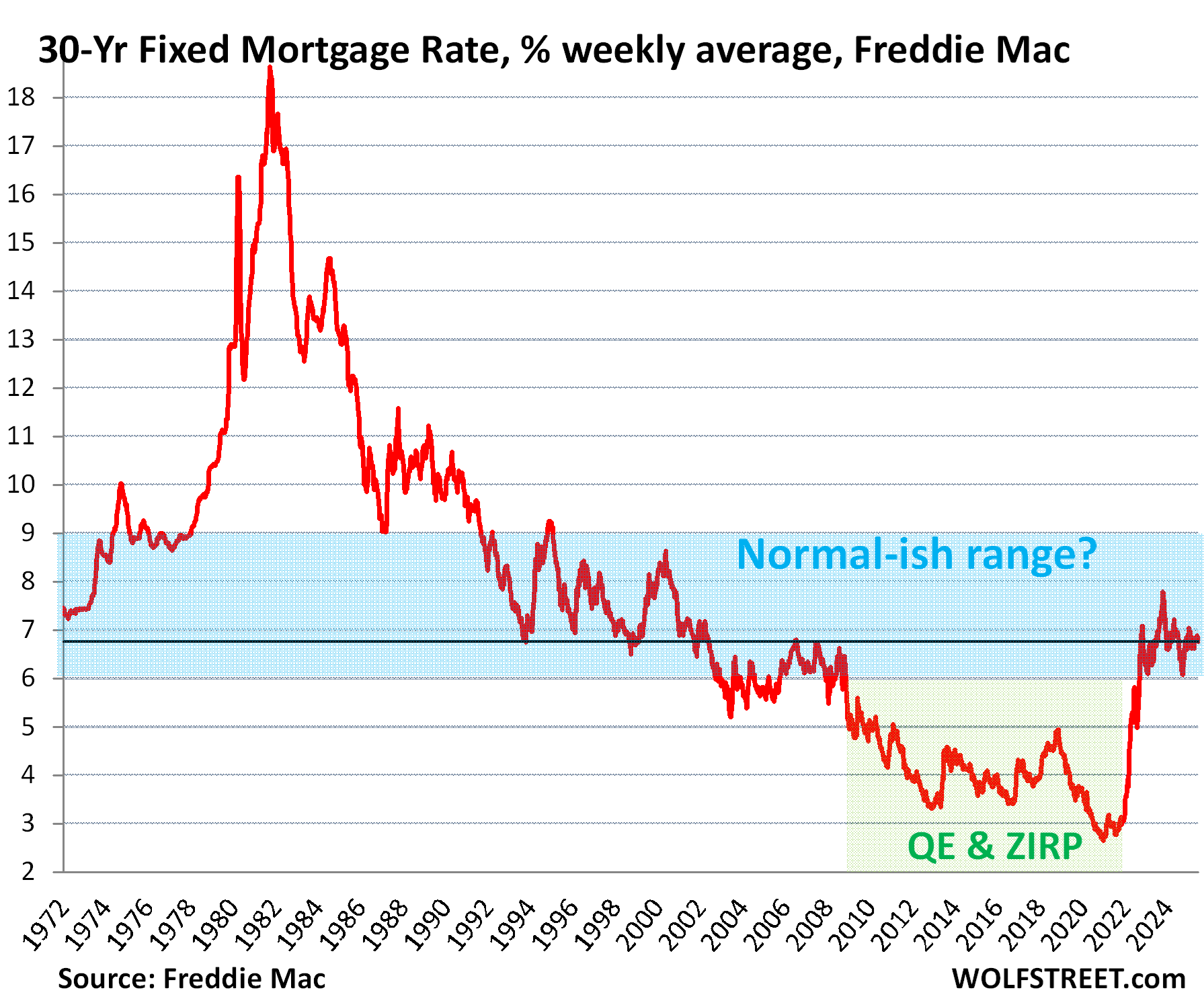
The share of 4-5% mortgages dipped by 20 basis points to 17.9% in Q1. That share is the lowest in the FHFA’s data going back to 2013.
Some of these mortgages were refinanced into lower-rate mortgages when mortgage rates began to drop in 2019. Then in Q2 2020 through Q1 2022, the tsunami of refinancing caused their share to get cut in half, and their share has since then declined further.
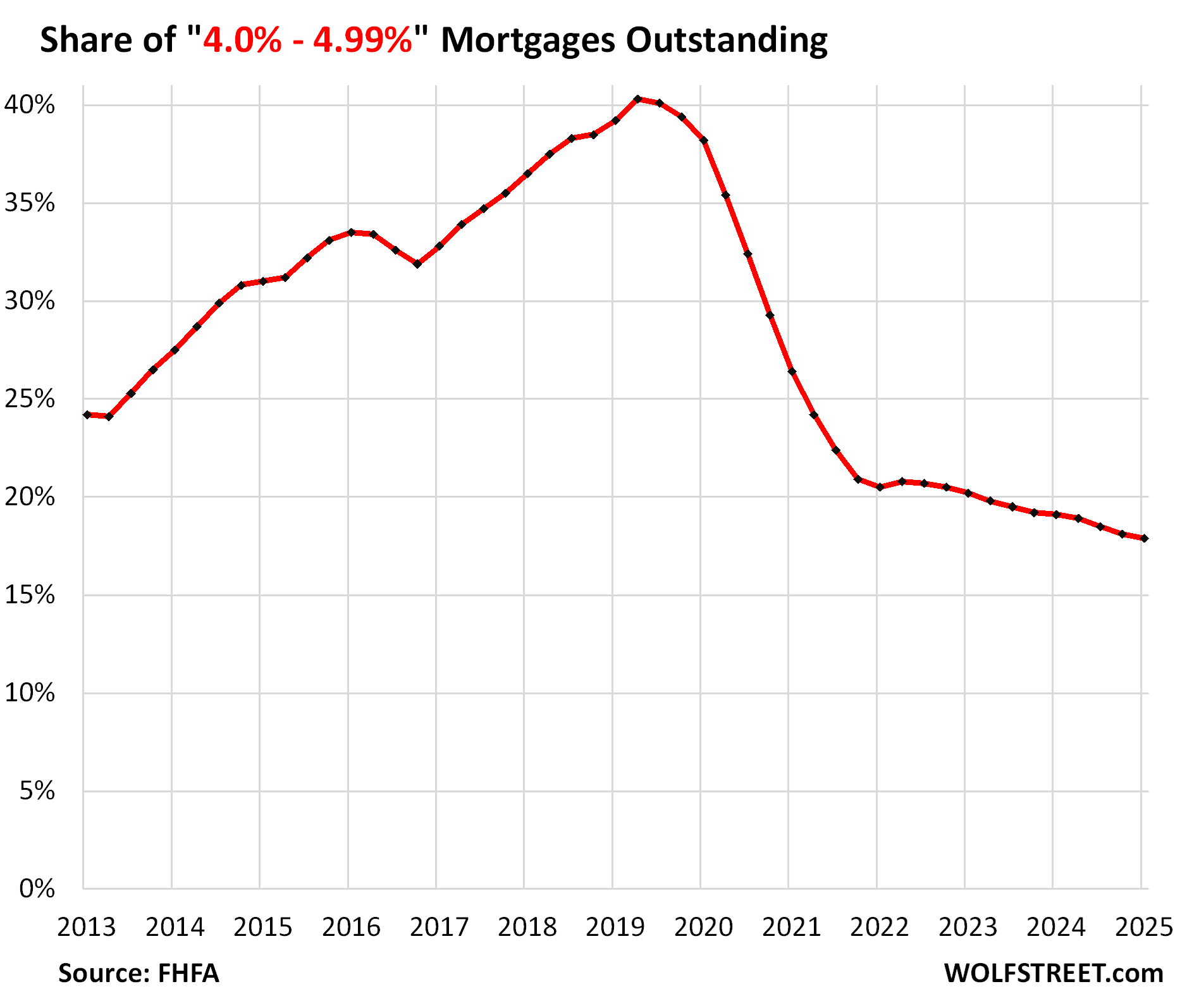
The share of 5-6% mortgages has remained roughly stable over the past two years, mostly just under the 10%-line. In Q1, the share dipped to 9.9% of mortgages outstanding.
There are fixed-rate mortgages offered in this range. For example, the interest rate of the average conforming 15-year mortgage fell below 6% in February and has largely remained below 6%.
The long decline of the share of these 5-6% mortgages during the QE era to bottom out in Q1 2022 at 7.0% was interrupted only by the Fed’s QT and rate hikes in 2018, when mortgage rates rose, and the average 30-year fixed mortgage rate briefly hit 5% in November 2018. But in 2019, mortgage rates declined again amid the Fed’s rate cuts and end of QT.
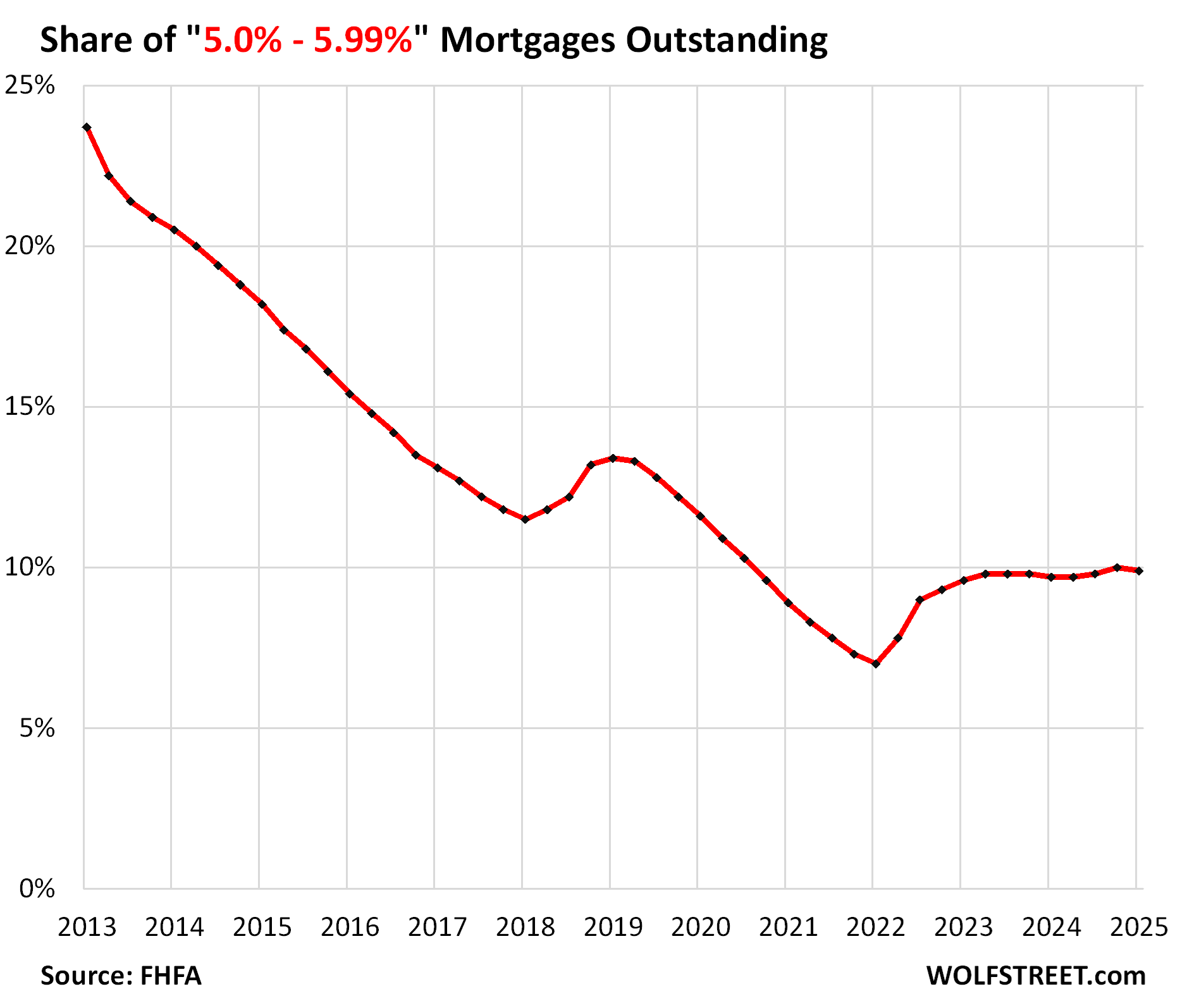
The lock-in effect has depressed demand for homes, and real estate brokers, mortgage lenders, and mortgage brokers have gotten hit hard by this plunge in demand and shed a large portion of their employment to deal with it (I discussed the effects here: Housing Bubble & Bust #1 and #2 as Seen through Employment at Mortgage Lenders: They Shed Jobs Again, 38% Gone).
Enjoy reading WOLF STREET and want to support it? You can donate. I appreciate it immensely. Click on the mug to find out how:
![]()


They always miss their exit. I love it. Better luck next bubble.
The way and speed we blow up the last bust to current bubble, wouldn’t doubt it the next one if this one EVER pop will re-accelerate even faster and bigger, maybe down to 1-2 year just like the Covid peak from bottom to top.
Unless there’s a generational narrative and mindset shift for the general public that housing is not a fool proof great return investment, people will buy into it another bubble again and again, especially if government have an incentive and benefit from high housing price such as tax revenue, wealth affect…etc
Oh no….seems like another one of RE and some of the house humpers talking point is slowly getting chip away. First it’s the generational lack of supply so price will stay high forever or the rate is temporarily high now but wait for that rate cut back to 2% so price will only go up, add the never ending “lock in” effect narrative so no one will ever reduce price to sell their place therefore price and market will never go through a painful correction and RE can go only up. Many cracks are forming now, what other talking points do they have left to justify that this is not a bubble…I am sure we can find something on /REbubblejerk
Realtors and most economists deny it, but this housing downturn will make the last one look like a day at Disneyland. It’s going to be absolutely devastating.
What if you consider a day at Disneyland devastating?
The Fed is a serial asset blower…central banks have been doing this for 300 years…the trump, Powell theater is like people think we have a 2 party system… housing is now unaffordable for young people across the board, student loans like old mortgages…it’s a plutocracy of thieves and grifters… with a printing press…
I will occasionally post this housing documentary unless Wolf asks me to stop. Two parties, one giant wall st. grift.
It is a lesson in how homes were turned into financial instruments.
TheCon dot TV
Since 1725??
hold my powdered wig sir!
What do you think the upcoming SLR changes will have on mortgage rates? From what I understand it will create 7 trillion dollars in demand for treasuries to hold long-term rates down which would essentially keep real estate inflated?
Yes it creates $7T OF ROOM ON BANK BALANCE SHEETS, but banks have no business owning long treasury securities.
“create 7 trillion dollars in demand for treasuries”
🤣❤️ you had way too much 🍺🍺🍺🍺🍺
it might not create much of any demand for Treasuries. Banks can make more money with zero risk by keeping their cash in their reserve accounts at the Fed, which is risk-free and instantly liquid and currently pays 4.40%.
But as Countrybanker said, it will create some room on bank balance sheets so that they can make more loans, such as C&I loans, which would be a good thing. And banks would make a lot more money on those.
I have to laugh. There are no adults left in the room, watching the economic decisions made with lamentable consequences.
20% increase in the price of gold in just less than six months. This is ugly. So, your house is now worth 20% less than it was on January 20- LoL, and everyone is now complaining about houses? Didja miss the rest of the disaster?
And we just took vacation properties out to be shot, just imagine how many people are going to come to LA for the Olympics. And everyone keeps thinking it is just going to be business as usual.
Nope. This is the new new. And it sure isn’t what we have been used to. It isn’t panic, if you go first and are right.
So many pieces are breaking, and we are not fixing anything, instead our government is intent on breaking everything.
But patience, we still have more to break. As Wolf keeps talking about, at least the Fed is still functioning. For now.
I am starting to become very pessimistic, and we still have a lot of trade stuff to solve.
Wait for Trump’s sycophant fed chief to lower rates to zero and then watch the fireworks start!
Well said.
See how it works is…
The stock market fell, so people pulled money out of there and made a ‘flight to safety’, ala went to gold or Bitcoin (lunacy).
now that the stock market is hot again (minus the 10% drop in dollar value thanks to the new policies), people may jump back in.
Then some bad news may melt the stock market again.
Then back to gold!
What pushes up the price is more investors in the finite amount of investment. Meanwhile Bitcoin is like 1000 people trapped in a miserable room, 5 begging to get out and promising you “it’s great in here! Give me $5k and I’ll give you my seat” nevermind the room is on the titanic
Bitcoiner here. Even if you give me 250k now, you won’t get my coin!
Easy fix Wolfman as far as +7% mortgage rate, just adjust lending standards to allow up to 53% of household income to pay for the mortgage.
That will loosen up the market and help to spur more sales.
Realtors should think about changing careers. Nothing is going to change. The only thing that will bring down interest rates, make homes more affordable, and create more churn in the market to boost their commissions is a major depression or repeat of the GFC of 2008/2009. That’s not going to happen any time soon.